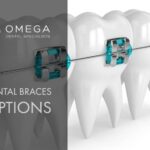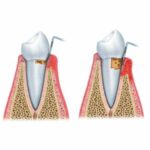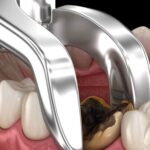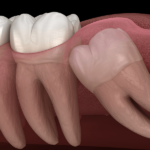Dental Cleaning Before Getting Braces and Cleaning Braces
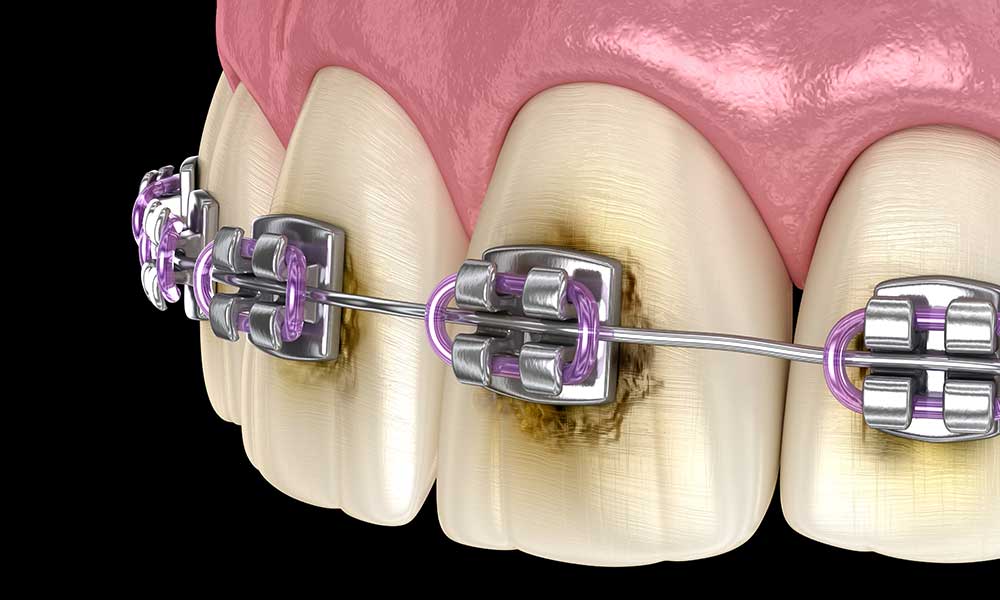
There are a few things to remember before you start your orthodontic treatment. The first step is to get your teeth cleaned before getting your braces and cleaning braces. It is best to make an appointment with a dental hygienist or a dentist to get your teeth cleaned before getting braces and every three months when you have your braces on.
Table of Contents
Why is it Necessary to Get Your Teeth Cleaned Before Getting Braces?
There are a couple of reasons that an orthodontist wants you to get a dental cleaning before starting braces. It is a precaution to make sure you have clean teeth to avoid dental problems that require treatment. With cleaning, you will also get the assurance that your teeth and gums are healthy and also that you are ready to start with your orthodontic procedures.
Additionally, the orthodontist would want to know if you have any decay exist in your teeth, before bonding the braces. If there is some tooth decay or related issues, your dentist would want you to treat it before getting braces. Braces are obstacles to the dentist’s ability to properly fix your teeth-related issues. With decay already there and then attaching braces on it without treating the decay makes the problem more severe. So, it is mandatory to get your teeth professionally cleaned before your braces.
What is the cost of teeth cleaning, before braces?
The average cost of teeth cleaning before braces is the same as that of the expense of teeth cleaning at any time. There is nothing unique or special about this one. The average cost of a basic dental cleaning, if you don’t have dental insurance, is about $118, not including required dental X-rays. The teeth cleaning cost, including exams and x-ray by a dentist, is about $198 in Houston, but your dental insurance pays for your teeth cleaning twice a year.
The teeth cleaning cost will also rely on the severity of any dental issues that you may have. If you do not have the habit of visiting the dentist regularly, then you may require a debridement procedure or scaling of teeth and root planning if your gums are not in good shape. This is usually called deep cleaning. If you require either of those, you will need to make sure your local orthodontist and dentist are working closely together to keep an eye on any potential dental issues.
What are we looking for, at the teeth cleaning, before braces?
Before getting braces, people may want to check several important things during dental cleaning. The foremost is to ensure that you have proper bone support and healthy gum. Orthodontic treatment can deteriorate any preexisting dental decay or gum problem. That’s why your dentist insists on having a dental checkup before braces. The second important reason is that the doctor wants to make sure you are decay-free. Next, he wants to ensure that there is no faulty dental work.
In case you get braces without a prior dental cleaning, then the plaque may build up in between the teeth. Plaque and calculus are the main cause of cavities. Plaque is the sticky white coating that is deposited on the surface of the teeth. Plaque can easily be prevented and eliminated by regular brushing of the teeth. The immune system will react to bacterial invasion and cause inflammation known as gingivitis. In the absence of treatment, this inflammation of the gums can create more complex periodontal problems. The dental cleaning before putting on the brackets will remove all of the plaque.
What is the best way to check for decay between the teeth?
Bitewing X-Rays are used to help detect early signs of dental caries to help keep your teeth healthy. Your dentist can find early evidence of dental caries which can be reversed if caught early enough. When bitewing x-rays are used, your dentist will be able to detect any changes to the enamel in your teeth early.
Most tooth decay is diagnosed through a visual exam. It’s difficult, if not impossible, to see the surfaces of your back teeth. Dental x-rays are used to determine if there are any signs of caries in your teeth.
Bitewings x-rays are taken in a series of four to take a careful look at your teeth to see if there is any potential decay. If you already have plenty of filling, bitewings may be taken each time you visit the dentist. This process provides a clear look at the dental health of your mouth, giving your dentist plenty of information to work with.
Most adults will have two bitewings x-ray taken per side of the mouth, while younger children only need to have one bitewing taken on each side. There’s minimal risk to getting x-rays, as long as the dentist uses a lead collar and apron for protection from any potential radiation exposure. Your dentist may take bitewing x-rays every six months while you are a child, or if you have significant dental caries that in your mouth. When you are at risk for further dental decay or periodontal disease, you may need bitewing x-rays during each six-month visit.
How to clean braces?
- Brush twice a day thoroughly for 2 minutes to remove plaque from the surfaces of your teeth.
- Flossing twice a day will help remove plaque that is present between your teeth, and that is also under your gum line, where your toothbrush usually may not reach properly.
- Reduce sugary or starchy foods, particularly sticky snacks.
- Schedule regular dental visits for professional dental cleanings and examinations every six months.
Some foods don’t do so well when braces are on, as they can pop the braces and damage the wires, which will not only destroy your day but will make you run back again to your orthodontist for repeated repairs.
This includes:
- Nuts and hard lollipops: They’re the critical offenders for broken wires in regards to brackets, so get your fix before your braces are fitted!
- Chewy and starchy foods (such as toffee): They may cause severe damage to the brackets on your metal braces
Popcorn – Braces can act as a catcher for popcorn, so get the fill-in the week before your braces treatment! - Hard crust pizza and bread
- Crunchy fruits and vegetables, like whole pears, oranges, and carrots
If you have not already done with your dental cleaning within the last few weeks, go back to your dentist for a dental checkup, scale, and get your teeth cleaned. Your orthodontic practice needs your teeth as well as gums to be completely healthy before they fit your brackets.
Also, be sure to brush your teeth and floss daily thoroughly.
There are certain foods; you should avoid while you are wearing braces, such as:
- Hard or tough to bite foods such as apples or bagels
- Chewy food such as toffee or caramel
- Corn sticks
- Hard crackers, popcorn, nuts, and carrots
Follow the tips and suggestions and have healthy and happy dental hygiene. Happy smiling.
Braces may seem like they require a high amount of maintenance. Taking care of your braces doesn’t have to be a hassle if you take special care to ensure your teeth are healthy. Extra care may need to be taken if you have non-metal braces. Here is a list of how to take care of your teeth while you have your braces in.
Wearing braces doesn’t mean you have to miss out on eating hard foods. It just means that you must be extra careful with what you eat regarding how hard the food is. Eating hard foods can result in the wires in your braces snapping or pop-off. How do you know what to eat or what not to eat? If you can break the hard food down into smaller pieces, then it would be acceptable to eat.
An example of this would be hard fruit such as apples and carrots. Another acceptable answer is if you place the hard food in your mouth, and it breaks down and becomes softer due to saliva. An example of this would be a pretzel. Other foods to avoid are beef jerky, peanut butter, gummy worms, or anything that can potentially get stuck in the braces, maybe too hard, or are too sticky. If you eat something that has gotten stuck in your braces, you can try to get it out, but it is best to refrain from consuming sticky foods. Trying to get sticky food from braces can be a challenge, and there is a chance that your braces can break.
Sugary food and beverages invite bacteria that love to cause plaque. Just because you have braces doesn’t mean you can’t indulge if you do, be sure to brush and floss your teeth afterward. Don’t wait too long to brush your teeth after indulging in sugary foods because plaque and its buildup can spread to various parts of your braces, such as the brackets of your braces and surrounding areas. The thing to remember about braces is that you must give your teeth the tender loving care it deserves and that includes brushing your teeth a little more than usual. After all, the foods that you eat can get stuck in your braces, so you must be careful of that happening now and then. You also run the risk of damaging your braces, trying to get food particles out of them. Tooth decay is a huge problem, but what better way to minimize it than simply brushing your teeth? It is essential to practice the art of brushing your teeth with braces, but how should you do so? Is there a right or wrong way to brush?
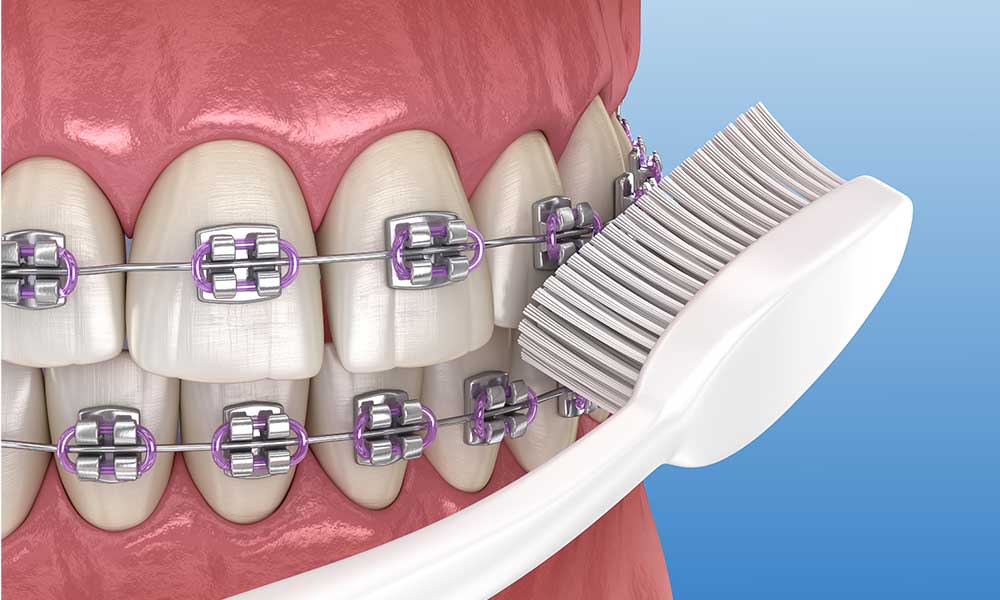
How to Brush Your Teeth with Braces:
The first thing to do before you start brushing your teeth is to remove rubber bands, which are usually connected from the top of the mouth to the bottom. Removing rubber bands allows you to quickly brush your teeth in and around the braces as well. Interarch rubber bands are commonly confused with ligature bands, which are usually come in various colors. The ligature bands connect your teeth and do not need to be taken out in this case. If you have non-metal, removable, or clear braces, all that is necessary to brush your teeth is to remove them. You can presume your normal brushing and flossing routine. Always put your braces back in their case when not in use to avoid any outside germs and bacteria. The case also comes in handy when it comes time to reuse the braces; you know exactly where they are.
Start by rinsing your mouth out with water. This loosens any food particles and makes it easier to get them out. Swish the water inside of your mouth thoroughly, then spit it out. Now you are ready for brushing. Brush your teeth and be very thorough. The areas you need to brush and pay attention to are your teeth, gum line, and brackets. Tilt the toothbrush to a 45-degree angle and let the brushing begin. The gum line should be the first thing you brush, then get the top and bottom of your mouth and lastly, brush the brackets. When brushing, focus on how much pressure you are using on your teeth. Try not to brush too hard or rough when you brush your teeth because of the risk of your wires breaking. Wire damage can occur in non-metal braces, metal, or clear braces. Brushing your teeth and braces should take two minutes each time. After brushing, rinse your mouth again using more water. If you have clear braces, brush them separately by using a small amount of toothpaste to brush them with and end by rinsing.
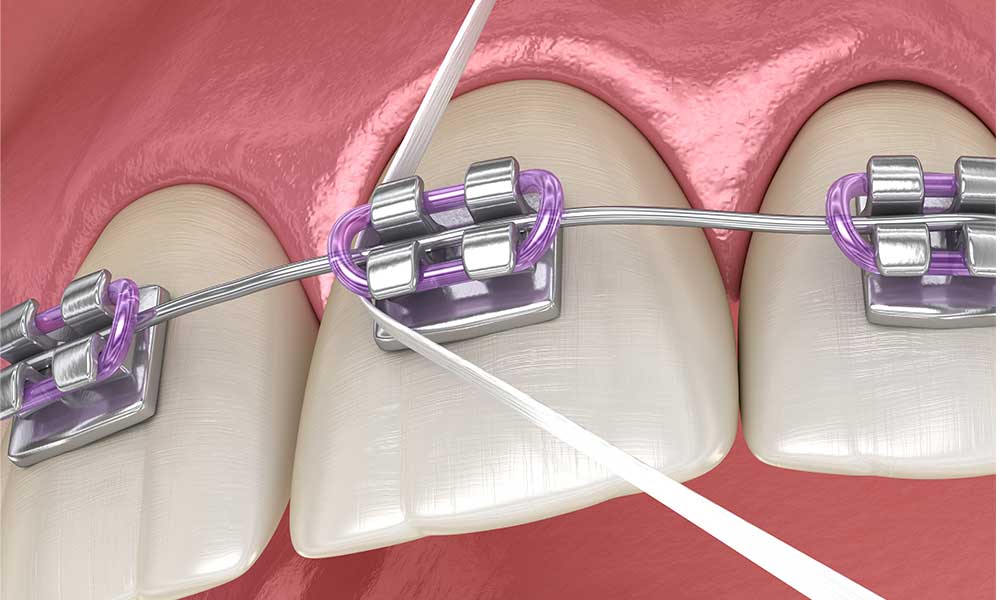
How Often Should I Floss?
It is recommended that you floss once a day. If you would like to floss more than once a day, that is fine. Some people don’t have time to keep up with flossing habits, and that is where a floss threader can come in to make it easier. A water jet helps too. If you don’t have those things, flossing has always worked and will never go out of style. Flossing once, in the morning, is acceptable if you don’t have time to floss later in the day. In the morning, after flossing, you can change your inter-arch rubber bands. They need to be changed daily anyhow. The bands endure a significant amount of stress throughout the day. If you haven’t changed your bands from the previous day, changing them in the morning is a good idea.
How To Clean Your Invisalign Tray?
Best of all, Invisalign Express is virtually entirely painless. Unlike metal braces that can cause pain and even injury, Invisalign takes a much softer approach to correct tooth alignment. In short, Invisalign Express does not hurt. Even kissing becomes less of an issue with Invisalign as compared to metal braces. Another important tip to take into consideration about Invisalign Express is that toothpaste is not a good substance for cleaning aligner trays. Toothpaste is abrasive in nature and will eventually cause aligner trays to become more noticeable.
The trays may even develop an odor over time because of toothpaste use. Always opt for a mild detergent or soap or perhaps a commercially available cleaning solution designed specifically for cleaning aligner trays. Invisalign Express is an excellent way to take full advantage of all that modern Invisalign has to offer but in a time-condensed and faster way. While traditional Invisalign can take anywhere from 1 to 2 years to become fully effective, Invisalign Express can often achieve similar teeth-straightening results in just six months to one year. Talk with your dental care provider to learn more about Invisalign and all that it has to offer regarding improving oral functionality and creating a more attractive and impressive smile.
If you have clear braces, it is best to stay away from drinks that stain them, such as coffee, dark alcohol, or wine. Smoking is one of the things that have a chance of staining them too. If you engage in any of these activities, be sure to brush your teeth and braces soon after.
When eating, you should take your braces out since it is acceptable to be taken out for a short period. When not in use, be sure to place them back in their case where they belong. Putting your braces back in their case reduces germs and minimizes misplacing.
Red Wine Or Coffee Can Stain Invisalign Aligner Trays
Another important tip to consider in Invisalign is to always carry a travel toothbrush whenever possible. This allows you to clean between meals and maintain better oral care when using Invisalign. Equally important is to avoid certain types of foods and beverages. For example, drinking any liquid or beverage that can stain your teeth such as red wine or coffee can also stain Invisalign aligner trays. Any time it is necessary to drink a liquid that may stain it is best to remove the aligner trays first and then brush immediately following the consumption of these types of liquids.
As a side advantage, Invisalign Express may allow an individual to lose weight in a more healthy way. For example, midday snacks and binge eating may be curtailed or reduced considerably simply because the patient is more aware of their eating habits when wearing Invisalign Express aligner trays. When snacking on unhealthy foods is reduced or eliminated, natural weight loss will occur. Clothes begin to fit better, and patients experience greater levels of energy and wellbeing. This is just one more side benefit of Invisalign and its innovative and unique approach to improving oral functionality and outward visual appearance.
How to Clean the Teeth?
These points need to be remembered while brushing:
- Brushing with full attention every day
- Brush to the corner of the mouth while brushing. Do the brushing slowly, the brush in haste cannot clean the teeth properly, many places are left with food remains. So always slow down and brush in every corner of the mouth.
- Brush the upper part of the lower jaw teeth as well as, the lower part of the upper jaw teeth along with the sides of the teeth.
- Do not forget to clean the gums, softly.
Using floss to clean teeth is also very beneficial. It reaches easily in the places where the brush cannot reach. It helps a lot to get rid of the particles and particles of food trapped between teeth. If these particles are not taken out on time, they will cause tooth decay; bacteria begin to form in the mouth, causing teeth to become weak. Cleaning the teeth with floss 3-4 times a week (and one time a day) is one of the best ways to clear the leftover food particles. You can get dental floss easily from anywhere.
Benefits of Mouthwash
Mouthwash plays a vital role in killing bacteria in the teeth. Because there are Listerine & chlorine dioxide properties. It also helps in extracting food grains trapped in teeth.
When we do not rinse properly after eating, the particles of food are trapped in the teeth, which begin to decompose in the teeth. And this rottenness invites teeth-related diseases. Therefore, after feeding daily, properly rinse using mouthwash.
Clean up tongue
In the same way, we try to take care of the teeth; the tongue should also be looked after as well. Because whatever we eat, we taste it through the tongue, and then it goes straight into the stomach. And if the tongue becomes dirty, it will create germs and in turn, will spoil your stomach. To avoid this, use the Tongue Cleaner. You can clean the tongue with a brush or any thread as well.
Tips for maintaining the Toothbrush:
- Always keep your brush in a clean, dry place.
- Always clean your brush with hot water before brushing.
- The toothbrush should always be kept with a toothbrush cap.
- Leaving it open makes it prone for the germs to contaminate and even insects can sit on it and spread microbes.
February 15, 2023What Is The Average Cost Of Braces In Houston?
July 26, 2022Should I Have My Wisdom Teeth Removed Before I Get Braces?
September 23, 2021Pain After Braces
September 15, 2021how much does invisalign cost?
September 14, 2021Dental Cleaning Before Getting Braces and Cleaning Braces
May 18, 2021Braces Colors
January 18, 2021What you need to know about Invisalign Houston
November 24, 2019Invisalign and Braces Alternatives
